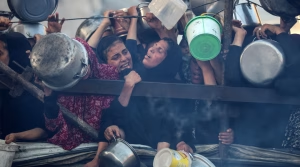In the year 2000, Samah Salaime, a social worker who was living in Jerusalem, could not find a school for her four-year-old son. As a Palestinian citizen of Israel, she was entitled to send her child to a Jewish public school, but no Jewish school in Jerusalem would accept him.
That rejection was the impetus for her and her husband to move to the village of Neve Shalom/Wahat al-Salam (Oasis of Peace), a bi-cultural community made up of an equal number of Jewish and Palestinian (Christian and Muslim) citizens. The community runs the School for Peace, a bilingual and bi-cultural primary school for the village and the surrounding district.
Salaime and fellow Oasis of Peace resident Vared Marom spoke about the their community as a model for a shared Israeli-Palestinian society at JSpaceCanada’s annual general meeting in Toronto on Nov. 28.
The event , which drew about 100 people, was hosted by Holy Blossom Temple and co-sponsored by the Canadian Association of Jews and Muslims, with support from the Foundation for Ethnic Understanding.
The discussion was moderated by Carlton University political science Prof. Mira Sucharov. Israel’s consul general in Toronto, Galit Baram, was also a guest speaker.
Marom, a letterer in nutrition at the Hebrew University of Jerusalem and a mother of four, said she applied to live in Oasis of Peace because she felt she should be better acquainted with Israeli Palestinians.
READ: ISRAELI, PALESTINIAN DOCTORS PROMOTE JOINT HEALTH INITIATIVE
After completing her military service, she travelled around North and South America for four years. When she returned to Israel, she felt that it was ironic that she had spent so much time familiarizing herself with Latin American culture, but knew so little about the Arab Israelis in her own backyard.
She told her future husband that she wanted to settle in Oasis of Peace. It took seven years, because there’s a big waiting to list to live there.
She said there are now 300 residents living in the community, but an additional 90 families (there are 300 on the wait list) have been approved to live in the village, as more housing comes online.
The community was founded in 1970 by a Dominican priest, who was able get 50 hectares of land between Tel Aviv and Jerusalem from a Trappist abbey. The founder envisioned an ecumenical society of Christians, Muslims and Jews who would be a part of a shared community.
The first families moved there in 1978 and established the School of Peace that same year.
Marom said the kids from different faiths grow up together: “In our living room, Jewish and Arab kids are listening to music together … they go out together … 70 per cent of the kids want to come back and live here.”
We are training the next generation of leadership.
– Vared Marom
The Israeli national newspaper Yedioth Ahronoth chose Salaime, a community activist and feminist, as one of the country’s 10 most influential social activists. The mother of three was born in a northern Israeli town located between Haifa and Tiberius. She pointed out that many members of her extended family have been living in Syrian refugee camps since 1948.
Her parents – both were teachers – encouraged her and her three sisters to get a college education and they all attended Jewish public school, which had high academic standards, she said.
She earned a bachelor’s and a master’s degree in social work at Hebrew University. Salaime said she was shocked by the ignorance of the Jewish students. “They didn’t know Arabic, or anything about me,” she said. “There was no meaningful relationship.”
Salaime and Marom explained that they celebrate each other’s holidays, except for Yom ha-Atzmaut, because the Palestinian Israelis observe Nakba Day on May 15, to remember the exodus of thousands of Palestinians when the State of Israel declared its independence.
Many other groups would like to establish shared societies like Oasis of Peace, but there is not enough land. Other applications for land have been rejected by the Israeli government, which controls more than 90 per cent of the land in Israel, Salaime explained.
“There have been 60,000 graduates from the the School for Peace and it’s common for many of its graduates to become human rights activists, Marom said.
“We are training the next generation of leadership. When government leaders are ready to listen, we have something to teach them.”






